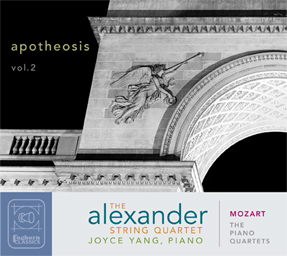apotheosis
(vol.2) mozart piano quartets
ALEXANDER STRING QUARTET
JOYCE YANG, PIANO
FCL 2018
Recording of the Month
“Elegance and poise...”
“These have been recorded in a fairly intimate acoustic that would be mercilessly revealing of any weakness, but each and every one of these musicians acquits themselves with aplomb. I like Joyce Yang’s subtle feel for Mozart’s dynamic shading, witty turns of phrase and lyrical lines, as well as the way she blends with the strings where the music demands. … I very much enjoy the Alexander Quartet’s consistent high quality and the sense of delight they impart to this music, and for these and many other reasons, it would be most welcome on my desert island.
”
— Dominy Clement, MusicWeb International (January 2017)
First (rave) review of Apotheosis, vol. 2:
“But what really sets these readings apart for me is the ways in which these musicians connect the dots, so to speak, and find just the right moments and just the right ways in which to reveal to us Mozart’s underlying grand plan.… This is truly phenomenal both in terms of the playing and the recording. … That said, the only word to describe the Alexander Quartet members and Joyce Yang’s playing of [The Piano Quartet in E-flat Major, K 493] is exquisite.”
— Jerry Dubins, Fanfare Magazine
“Neither of these works, to put it mildly, plays itself.
... The members of the Alexander String Quartet resolve these questions through assiduous clarity and refinement allied to a varied but palpable sense of warmth. The results circumvent arid arguments about performance style and overt romanticizing of Classical repertoire. The two piano quartets emerge naturally and unaffectedly with phrasing that breathes, with rubato that speaks, and with caesuri that ensure the music’s punctuation is never forced but equally never lapses into sentimentality.”
— Jonathan Woolf, MusicWeb International (June 2015)
Excerpt from the liner notes by Eric Bromberger:
Some have claimed that Mozart invented the piano quartet, but he did not. Other composers — including the fourteen-year-old Beethoven — had written quartets for piano and strings earlier, but Mozart was the first to face squarely the challenges of this difficult form, and
he wrote the first two great piano quartets. That form would go on to enjoy a measure of popularity across the nineteenth century in the hands of Mendelssohn, Schumann, Dvorzak, Brahms, and Fauré, but it presents composers with problems, particularly in the combination of the string trio (itself a problematic form) with a piano. How does one successfully combine the resonant, sustained sound of three stringed instruments with the percussive strike of the piano? And how does one integrate three separate string voices within the full range of the piano? Mozart addressed these issues in his two piano quartets, written in the months surrounding his thirtieth birthday, and solved them in different ways.
The history of the composition of these two works is interesting for what it tells us about the changing dynamics of musical life in Vienna at the end of the eighteenth century. By 1785, four years after his move to Vienna, Mozart was beginning to look toward new avenues of income. He had up to this point supported himself as composer, performer, and teacher, but now he began to recognize that significant income might come from publishing music that would be purchased by amateur performers, whose number was growing in the final decades of the century. Toward that end, he entered into an agreement with his friend Franz Anton Hoffmeister to publish a number of his works. Specifically, Hoffmeister contracted with Mozart to write three piano quartets, and he paid the composer an advance on the income he expected from them. But the first of these, the Piano Quartet in G Minor, did not sell well — those who bought it complained to the publisher that it was too difficult. Hoffmeister brought this unwelcome news to the composer, and they reached an agreement: Hoffmeister let Mozart out of the contract and allowed him to keep the advance. But eight months later, free of any obligation, Mozart went back to the form, wrote the Piano Quartet in E-flat Major, and published it with Hoffmeister’s rival Artaria. And with these two works, Mozart apparently satisfied his interest in the form — he would live five more years and write nearly 130 more works, but he never wrote another piano quartet.
(Excerpted — liner notes include discussion of each quartet)
More Mozart:
Brahms & Mozart — Clarinet Quintets
Mozart Final Quartets (Apotheosis 1)
Mozart String Quintets (Apotheosis vol. 3)
Homage (”Haydn Quartets”)
Order Now
ORDER NOW
• • •
TRACK LISTING
Piano Quartet in G Minor, K.478
1. Allegro
2. Andante
3. Allegro moderato
Piano Quartet in E-flat Major, K.493
4. Allegro
5. Larghetto
6. Allegretto
